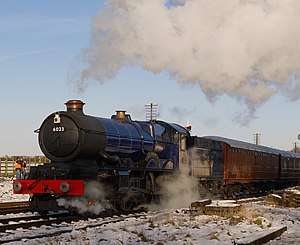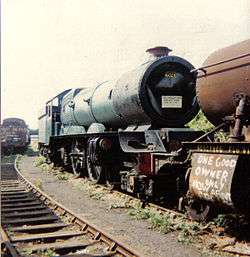GWR 6000 Class 6023 King Edward II
Great Western Railway (GWR) 6000 Class 6023 King Edward II is a preserved steam locomotive.
| King Edward II | |||||||||||||||||||||||||||||||||||||||||||||||||||||
|---|---|---|---|---|---|---|---|---|---|---|---|---|---|---|---|---|---|---|---|---|---|---|---|---|---|---|---|---|---|---|---|---|---|---|---|---|---|---|---|---|---|---|---|---|---|---|---|---|---|---|---|---|---|
 GWR No.6023 King Edward II at the Great Central Railway | |||||||||||||||||||||||||||||||||||||||||||||||||||||
| |||||||||||||||||||||||||||||||||||||||||||||||||||||
| |||||||||||||||||||||||||||||||||||||||||||||||||||||
| |||||||||||||||||||||||||||||||||||||||||||||||||||||
| |||||||||||||||||||||||||||||||||||||||||||||||||||||
Operational career
The locomotive was built at GWR's Swindon Works, out-shopped in June 1930. For most of its working life it was allocated to Newton Abbot and Laira (Plymouth), working express passenger trains to and from Devon to London Paddington. Withdrawn from Cardiff in June 1962, it was sent to Swindon for breaking up.[1] However, in light of the installation of a new bridge west of Bristol towards South Wales, it was coupled to its twin, 6024 King Edward I, and towed to the bridge for weight testing purposes. With both locomotives now closer to South Wales than Swindon, the decision was made to sell them to Woodham Brothers scrapyard in Barry Island.
Preservation

Whilst King Edward I was saved in 1974, King Edward II remained at the scrapyard due to the rear driving wheels being flame-cut following a derailment at Woodham's. However, as part of the 150th anniversary of GWR's formation in 1985, the hulk was acquired by Harvey's of Bristol, and was moved to a bay platform at Bristol Temple Meads railway station called the Fish Dock.
Restoration
The Brunel Engineering Centre Trust, under a Manpower Services Commission (MS) scheme, completely dismantled 6023 and restoration began. Work continued until the autumn of 1988, when the MS scheme funding was withdrawn and the future of 6023 was cast into doubt.
6023 was then bought by the Great Western Society (GWS) and moved to Didcot in March 1990 for its restoration to continue. The restoration has included the casting of new rear driving wheels in 1994, followed by re-wheeling the chassis in 1995. The casting is notable since it is thought to be the first wheels to be created for a standard gauge locomotive in preservation. The damaged wheels were also acquired by the GWS at Didcot and can today be seen on display there. Unlike the other preserved "King" class locomotives, the GWS decided to restore 6023 to its as-built single-chimney configuration. All "Kings" had been converted to double chimneys under British Railways ownership, which improved performance and efficiency but changed the original appearance.
On 12 April 2010, King Edward II's boiler passed its steam test, and on 20 January 2011 it moved for the first time under its own power since 1962.[2] It was due to re-enter service on 2 April 2011.[3]
Initially, King Edward II has been painted in the early BR express passenger blue livery, rather than the later standard BR Brunswick Green livery currently carried by 6000 King George V and 6024 King Edward I.
Return to service
The locomotive re-entered passenger service on the Mid-Norfolk Railway on 4 June 2011, as part of a running-in programme leading to the engine's return to the main line.[4] During the road journey to Dereham, the locomotive lost its safety valve cover, with the Mid-Norfolk offering a cash reward for its safe return.[5] The cover was restored to the locomotive by Sunday 5 June.
On return to Didcot, it was found that a number of copper firebox and boiler stays had broken, resulting in the need for a large amount of remedial work to the boiler. On 6 September 2012, the locomotive was moved to Loughborough on the Great Central Railway for firebox repairs, which were completed during early 2013.[6][7] The locomotive then made a series of appearances on the Great Central Railway, for both testing and running-in purposes but was later returned to Didcot where it was to be prepared to operate on the main line. In 2014, the GWS was given derogation by Network Rail to use a portable GSM-R radio unit on 6023. This unit could then also be used on other GWS locomotives yet to work on the mainline, such as 2999 Lady of Legend and 4079 Pendennis Castle.
Owing to height restriction rules the locomotive had to be reduced in height to comply with the current Network Rail loading gauge (the max permitted height for steam engines being 13ft 1in and the original height of the kings being 4 inches over at 13ft 5in). This required the fitment of a cutdown cab and shorter safety valve cover alongside a shorter chimney. The shorter chimney however adversely affected the draughting. A new design of blastpipe with four nozzles was designed and fitted to the engine which after early indications had eliminated the draughting issues on the engine. The other preserved "King" class locomotives 6000 King George V and 6024 King Edward I are both fitted with double chimneys and therefore it was not possible simply to use the same proven blastpipe and chimney arrangement on 6023.
Owing to the amount of time the rectification work took alongside how short the amount of time was left on the engine's current boiler ticket, it was originally decided to postpone the engine's mainline certification until after the engine's next overhaul was completed. An announcement from Didcot later on regarding the ceasing of mainline operations owing to costs and wishing to get more use of their engines, 6023 would now not be undergoing certification to run on the mainline.[8] With mainline equipment no longer needed the engine will be re-fitted with its original cab and later on its original height safety valve cover and chimney which will also include re-fitting its original blastpipe. It is not however expected to undergo an overhaul straight away until space is available following completion of additional loco overhauls.
Notes
- Cooke, B.W.C., ed. (December 1962). "The Age of 'Kings'". The Railway Magazine. Vol. 103 no. 740. Westminster: Tothill Press. p. 808.
- "IIS7". Philneale6023.fotopic.net. Retrieved 3 November 2012.
- "News | Latest News". Didcot Railway Centre. Retrieved 3 November 2012.
- "Blue King on Mid-Norfolk - Heritage Railway Magazine". Heritagerailway.co.uk. Archived from the original on 2 August 2012. Retrieved 3 November 2012.
- "BBC News - Mid-Norfolk Railway offers reward for lost train valve". Bbc.co.uk. 2 June 2011. Retrieved 3 November 2012.
- Didcot Railway Centre newsletter, October 2012
- "Home". 6023.co.uk. Retrieved 3 November 2012.
- https://www.railadvent.co.uk/2019/12/steam-locomotive-6023-king-edward-ii-retired-from-mainline-work.html/amp 6023 retired from mainline work
External links
| Wikimedia Commons has media related to GWR 6000 Class 6023 King Edward II. |
